Brand positioning is one of those marketing terms everyone agrees on—but let’s be honest: Most brands are doing it wrong. And hey, it’s not always their fault. With all the myriad definitions, brand positioning frameworks to subscribe to, and industry trends to follow, it’s easy to fade away into the sea of samesies out there.
That’s precisely why I’ve compiled this guide.
I’ve compiled wisdom from eight industry-leading sources—top brand experts, best marketing books, and successful real-world campaigns—to help you understand a positioning statement and write a compelling one that will speak to your target customers.
Whether you’re a solo-founder, a seasoned marketer, a brand strategist, an agency pro (or anyone in between) looking to take a sharper edge to value proposition for you or your clients, in other words, this guide is written for you.
Now, are you ready to take your brand like a pro? Let’s dive in.
TL;DR
Brand positioning is how customers perceive your brand versus competitors — not a logo or tagline, but the space you own in their minds.
It matters because it helps you stand out, build loyalty, and guide all marketing and business decisions.
A strong positioning statement includes: your target audience, category, unique differentiator, benefits, and emotional essence.
Common strategies: value-based, quality-based, price-based, problem/solution, competitor-based, niche specialization, and emotional identity.
To build your strategy: define goals, research the market, identify differentiators, craft your statement, align your team, and apply it everywhere.
Avoid generic claims, broad targeting, inconsistency, overpromising, and staying static.
Measure success through brand awareness, loyalty, conversions, and competitive perception.
Bottom line: positioning isn’t optional — it’s the foundation that helps your brand stand out, stay relevant, and grow with purpose.
What Is Brand Positioning, Really?

Alright, so first, let’s get something straight- brand positioning is not just a clever tagline or attractive logo. It is the way your target customers imagine your brand. It’s a piece of the pie for the space you take up in their brains (and fingers crossed, their hearts) versus every other business that competes in your service category or market.
Think of it as this: If your brand had to walk into a room full of its competitors, what would make it look distinctive? What would it say and do, and why would anyone move it over the others?
Brand positioning is the sweet spot where what you do best intersects what your target audience values most—and what your competitors fail at. Here’s your opportunity to get ahead and stay ahead.
But believe this: if you’re not actively driving your brand positioning strategy, the marketplace will define it for you – this is nearly always bad news.
So, if you feel like your brand messaging is kind of “meh” or that your target audience sort of understands what you do but not why it matters, you’re likely grappling with fuzzy brand positioning. The good news? You’re not alone, and we will change that together.
Why Brand Positioning Matters
Let’s face it: in today’s crowded marketplace, all scream for attention. No matter what you’re selling, whether it’s software, skincare, or sandwiches, someone already out there is doing something sort of similar. That’s where brand positioning comes in, flying like a superhero cape.

- It helps you stand out. Strong brand positioning creates an easy-to-see line in the sand. It says to your audience, “Hey, we are no longer because we are your choice.” Without it, you’re contributing to the noise.
- Builds emotional connection and loyalty. If people get what your brand is—and it emotionally resonates with them—then they’ll stick around. The emotional linkage is where genuine brand loyalty resides. It’s also where you gain the authority to charge more money since your value offering is more than just features or price.
- More than just a marketing thing. Brand Positioning: Your whole business is built on brand positioning. Your marketing strategies? Sharper. Your product or service? More aligned. Your overall focus? Laser-like. It is not just about what you say—it’s about what you do and how you show up consistently and universally everywhere.
Here’s the reality everyone overlooks: positioning strategy is strategy, not a slogan. It’s the teleological north star guiding every decision, each next Instagram caption, and future five-year roadmap.
So yeah, it matters. A lot.
Core Elements of Effective Brand Positioning Statement
So, what does it really take to put together a strong brand positioning statement? It’s not speculation or simply “going with your gut.” It has a formula, and when you nail these core pieces, it all finds its click.
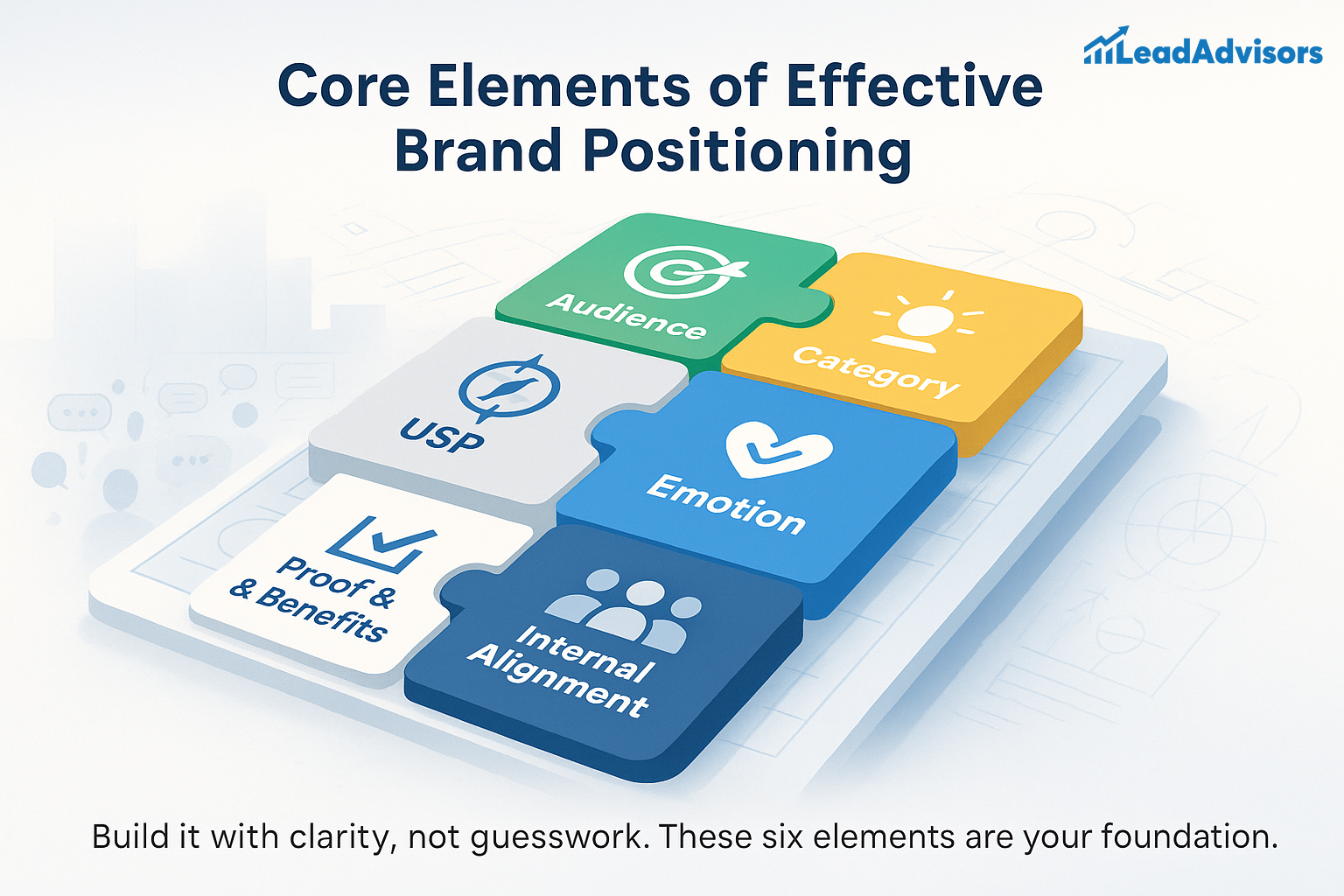
Know Exactly Who You’re Talking To (Target Audience Clarity)
The thing is, if your brand is trying to talk to everyone, it’s probably not connecting with anyone. Great brand positioning begins with knowing your target audience backwards and forwards.
- What do they care about?
- What keeps them up at night?
- What are they pulling their wallet out for?
Once you know your target market, your messaging will be much more magnetic, and your positioning strategy will be much more effective.
Be Clear About What You Do (Category Clarity)
What’s your lane? Are you a luxury skin care brand? A no-fluff SaaS platform? An accounting firm for creatives in the modern age? Claim your product or service category, since people need a frame of reference. In the grand scheme of things, your customers won’t remember your brand if they can’t “put” it somewhere in their heads (or make a purchase from you). That clarity is a vital step in any successful brand positioning.
Highlight What Makes You Different (Your USP)
Here’s where most brands fumble: they try to be better when they should be different. Your unique value proposition isn’t about being faster or cheaper—it’s about being the only brand that delivers that one specific thing for that one specific group. That’s how you position your brand in a way that sticks.
Show the Benefits (and Back Them Up)
Don’t just talk features. Focus on the benefit—what’s in it for your customer? Then, back it up with proof points: case studies, data, testimonials, and real-life wins. When people see both the promise and the evidence, that’s when trust kicks in.
Tap Into Emotion (Brand Essence)
Don’t just talk features. Focus on the value proposition—what’s in it for your customer? Then, back it up with proof points: case studies, data, testimonials, and real-life wins. When people see both the promise and the proof, that’s when absolute trust happens.
Make Sure Everyone’s on the Same Page (Internal Alignment)
People buy with emotion and justify with logic. That’s why the best brand positioning strategies go deeper than just the “what” or “how.” They tap into feelings—confidence, freedom, joy, clarity. That emotional layer? That’s your brand’s character, which keeps your loyal customer base returning.
How to Approach Brand Positioning: Types of Strategies That Work
There’s no one-size-fits-all approach to brand positioning. The key is picking a positioning strategy<span style=”font-weight: 400;”> that aligns with what you offer, who you’re serving, and how you want to be remembered. Whether you’re after a competitive advantage, stronger brand loyalty, or deeper target audience connection, the right choice sets the tone for everything.
Here’s a quick breakdown of the most common (and most effective) brand positioning strategies, sourced from New Breed, Hinge, Amazon, and Branding Journal:
| Strategy Type | What It Means | Examples |
| Value-Based | Focuses on giving customers more bang for their buck—more value proposition, less fluff. | Trader Joe’s, Dollar Shave Club |
| Quality-Based | Built around superior quality, craftsmanship, or performance. | Apple, Chipotle |
| Price-Based | Wins attention by being the most affordable or cost-efficient option. | Southwest Airlines |
| Problem/Solution | Solves a specific, nagging pain point better than anyone else. | Drift |
| Competitor-Based | Positions the brand in contrast to a known competitor—“We’re the better choice.” | Avis (“We try harder”) vs. Hertz |
| Niche/Industry Specialization | Becomes the go-to for a specific industry, role, or use case. | Vault Consulting, Walsh Colucci |
| Emotional/Identity-Based | Taps into the customer’s sense of self, values, or aspirations. | Nike, Dove |
Whether you want to lead with value, emotion, or expertise, your brand positioning strategy should align with both your target audience’s priorities and your brand’s unique strengths. That’s how you position your brand for the long haul.
How to Create a Brand Positioning Strategy (Step-by-Step)
Creating a brand positioning strategy doesn’t have to feel overwhelming. When you break it down, it’s really just a series of intentional steps—and once you walk through them, you’ll come out with a clear, confident positioning statement that actually works.
Let’s walk through it together:
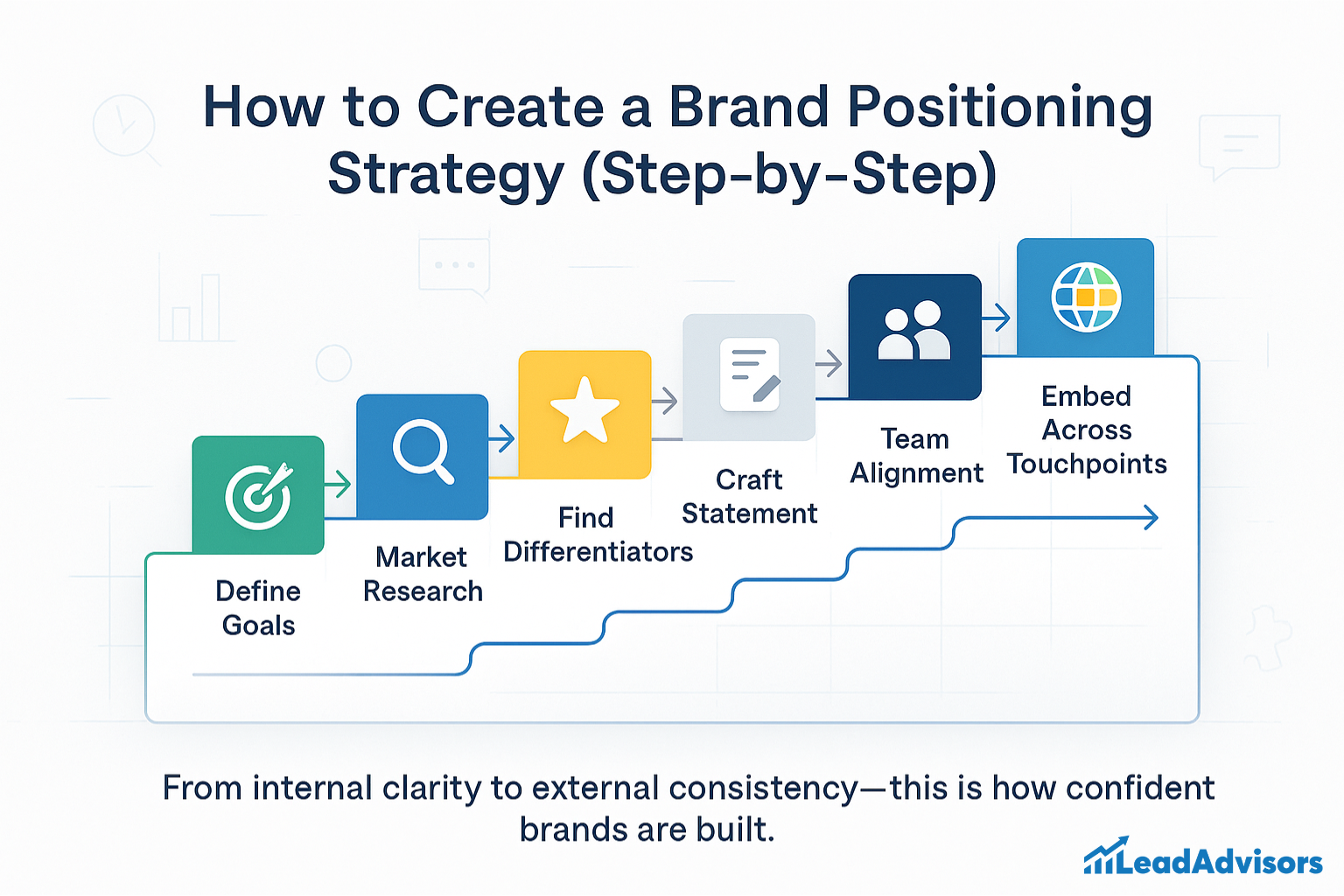
Step 1: Define Your Business Goals (Hinge)
Start with the big picture. What are you trying to achieve? More leads? A new market? Higher margins? Your brand positioning must support your goals, not just sound good on paper.
Step 2: Research Your Market, Competitors & Customers
Time to dive into the data. Look at what’s already out there—and where you can identify gaps.
- What are your competitors saying (and not saying)?
- What do your target customers really need, not just what they say they want?
- What trends are shaping your industry?
This is where the true brand positioning opportunities begin to emerge. Good market research and competitive analysis can find sweet spots your competition overlooked.
Step 3: Identify Your Meaningful Differentiators
So, what are you really doing differently here? Not fluff — points of distinction that are real and substantial. Here’s what your differentiation strategy should be checking off the boxes on:
- It’s a true statement about you (that you can prove)
- It’s demonstrable (you’ve evidence or results to show)
- It’s meaningful (your audience actually cares)
No one cares that you “care.” They want you to do things better — or differently — and in a way that benefits them. That’s the essence of what makes your brand unique.
Step 4: Craft Your Positioning Statement
Now that you have done the hard work, you are ready to join all these together into a strong formal positioning statement.
Here’s one that is classic and works wonders:
“For [target audience], [brand] is the only [category] that [differentiation] because [proof point].”
Write it as a one-liner or expand it to a paragraph, but keep it succinct, clear, and sure.
Example:
FlowCRM – For busy founders, the sales platform is built by two cofounders and supports lean teams! It allows them to close deals faster without having a sales army” behind them, he said, basing his view on data from more than 1,000 high-growth startups.
That’s how you position your brand in a way that clicks.
Step 5: Align Internal Stakeholders
This one’s big. Everyone—the leadership team, sales, and support—has to be aligned. When your team grasps your brand positioning statement, you gain messaging clarity that connects with the people important to your business through exceptional customer service.
Pro Tip: Hold a brand positioning workshop to ensure others have bought into and given feedback on your message, offering, and collateral.
Step 6: Embed It Across Every Brand Touchpoint
Now bring it to life. It’s not enough to just say something in your brand positioning — you have to live it.
Think:
- Your website copy
- Social media bios
- Visual branding
- Email footers
- Job postings and hiring flows
A confident brand positioning framework ensures that no matter where someone stumbles upon your brand’s identity, they feel the same vibe—clear, confident, and unmistakably you.
Real-World Brand Positioning Examples
Want to know what outstanding brand positioning looks like? These brands didn’t accidentally tap into success— they honed in on who they are, who they serve, and how they are different with a solid positioning strategy. Let’s break it down:
Corporate & Product Brands
Tesla

Tesla likes to fancy itself as the leader in the electric vehicle revolution. It’s not only about greenness — it’s about finding a way to make sustainability sexy. With cutting-edge technology and a sumptuous feel, Tesla has transformed what it means to drive an electric vehicle. This is a class act when it comes to quality-driven positioning strategy combined with a brave brand identity.
Apple
![]()
Apple has built a brand that’s as much about innovative-ness as it is about cool. Their brand positioning statement focuses on the ambition to inspire creative thinkers with intuitive, technically beautiful products. Apple’s product and service lineup feels exclusive, but even more important, it makes you feel like you’re a part of something smarter and more sophisticated. A clear differentiation strategy is what helps them remain iconic.
Nike
![]()
Nike is more than sports equipment—it symbolizes determination and self-affirmation. Their brand is for anyone who is chasing greatness, whether an Olympian or a weekend runner. Everything they do—ads, product design—is infused with empowerment, ambition, and attitude. That emotional pull? Timeless emotion-based brand positioning that creates brand loyalty like nothing else.
Dove
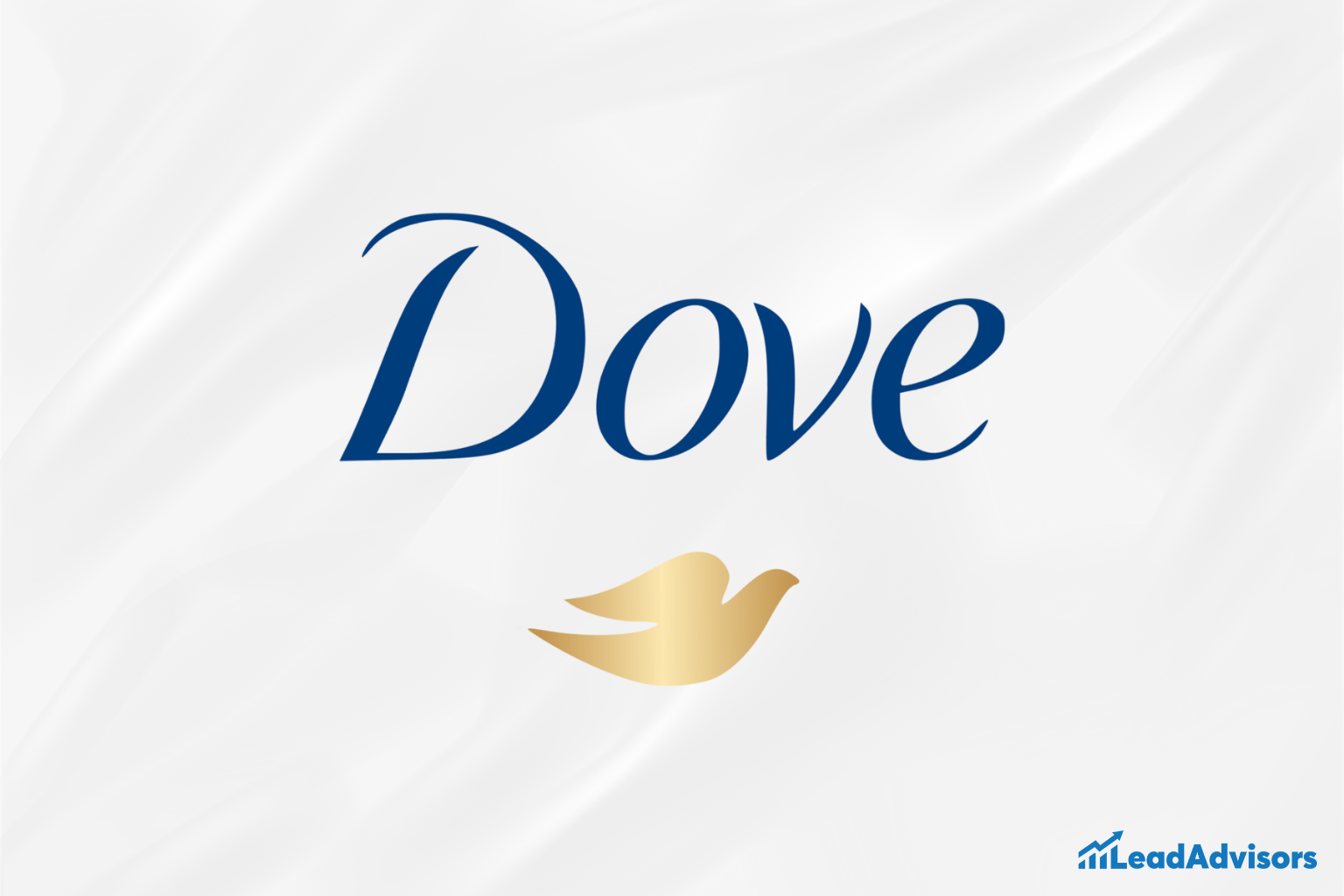
Ironically, Dove has completely transformed the beauty industry by starting a new movement of authenticity. Instead of idealizing a way of life, Dove celebrates real individuals and real stories. (Insert their method here.) Their placement strategy uses consumer perception: a desire to be seen, acknowledged, and included. It’s this identity-first mentality that has developed a relatable brand that can resonate.
Starbucks
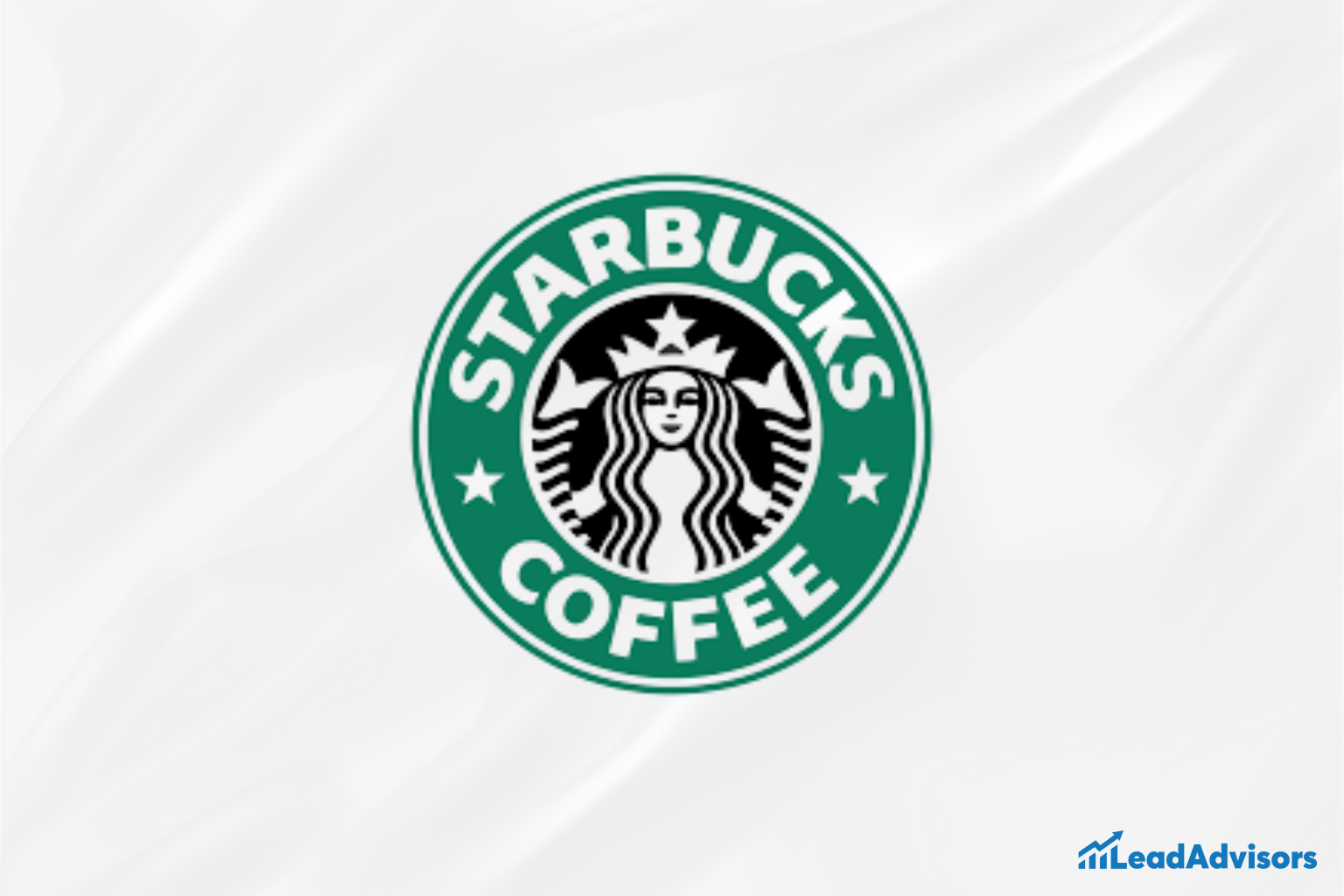
Starbucks doesn’t just sell coffee; it offers a uniform experience of coziness worldwide. Its brand embodies all about personalization, intimacy, and community. Whether you’re in L.A. or Tokyo, Starbucks has succeeded in winning over a loyal customer base by matching experience to expectations.
Drift
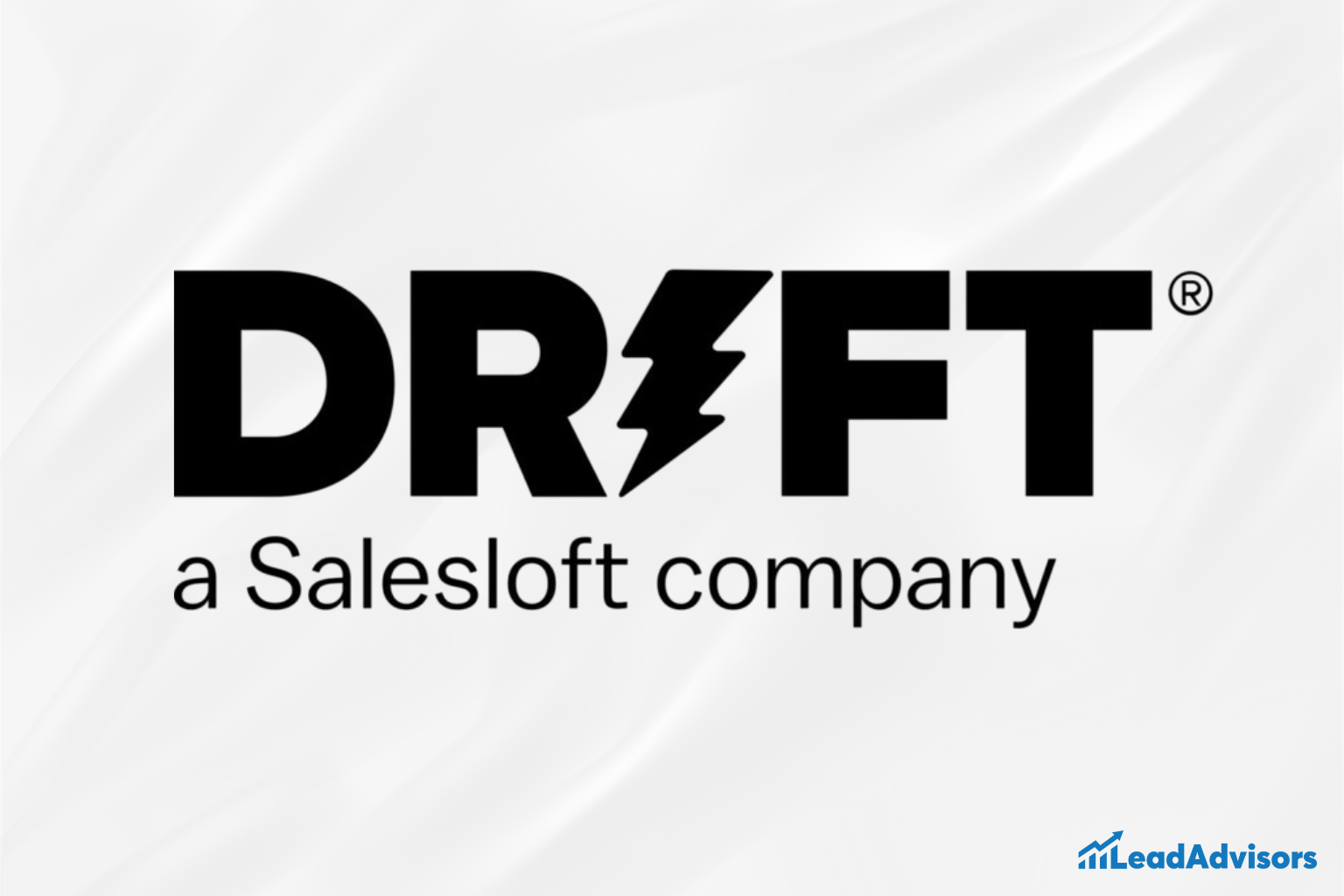
Drift turned the traditional B2B script on its head by focusing on conversations, not just conversions. Their unique value proposition lies in real-time, human-to-human interaction, cutting through automation. It’s a brand positioning strategy that taps into trust, speed, and transparency.
Ben & Jerry’s

Ben & Jerry’s is not shy about getting loud about what it believes in: social justice, environmental activism, super chunky, feel-good ice cream? That combo wins hearts. Their brand messaging is big and has a purpose, supported by values that are more than skin deep.
Professional Services Firms
Vault Consulting

Vault has flourished by providing a hybrid of accounting and research services to mission-driven nonprofits. The underpinnings of their brand positioning framework are insight-led support. It has less to do with the numbers, they know, and more to do with what truly fuels nonprofit impact. That’s positioning your brand with purpose.
Sellers Dorsey

Sellers Dorsey: This outfit takes the prize in Medicaid consulting. They make things easier for health care and government clients. Their brand positioning statement would scream authority, niche expertise, and proven success — an unexpected approach to brand positioning in such a complicated space.
Ascendient

We reimagine the future of healthcare at its essence with strategy and transformation. Their brand’s unique promise is forward-thinking advice, not plain advice. That’s what a market leader looks like.
Walsh Colucci

More commonly referred to as The Land Lawyers, they have carved out a grand haven of Virginia zoning and land-use law for themselves. They’ve laser-cut their domain through competitive analysis. Their brand positioning is enabled by deep local knowledge, legal expertise, and influence.
Summit Executive Resources

Summit, which places top executives, takes a high-touch, almost agent-like approach. Founded on the principles of trust and confidentiality, its brand positioning strategy is one of exclusivity. This service category succeeds or fails on the basis of personal relationships, not volume.
Each of these brands demonstrates that when you know precisely who you are—and, more importantly, who you’re for—you become unforgettable. That is the power of a successful brand positioning strategy.
Brand Essence Chart & Messaging Architecture
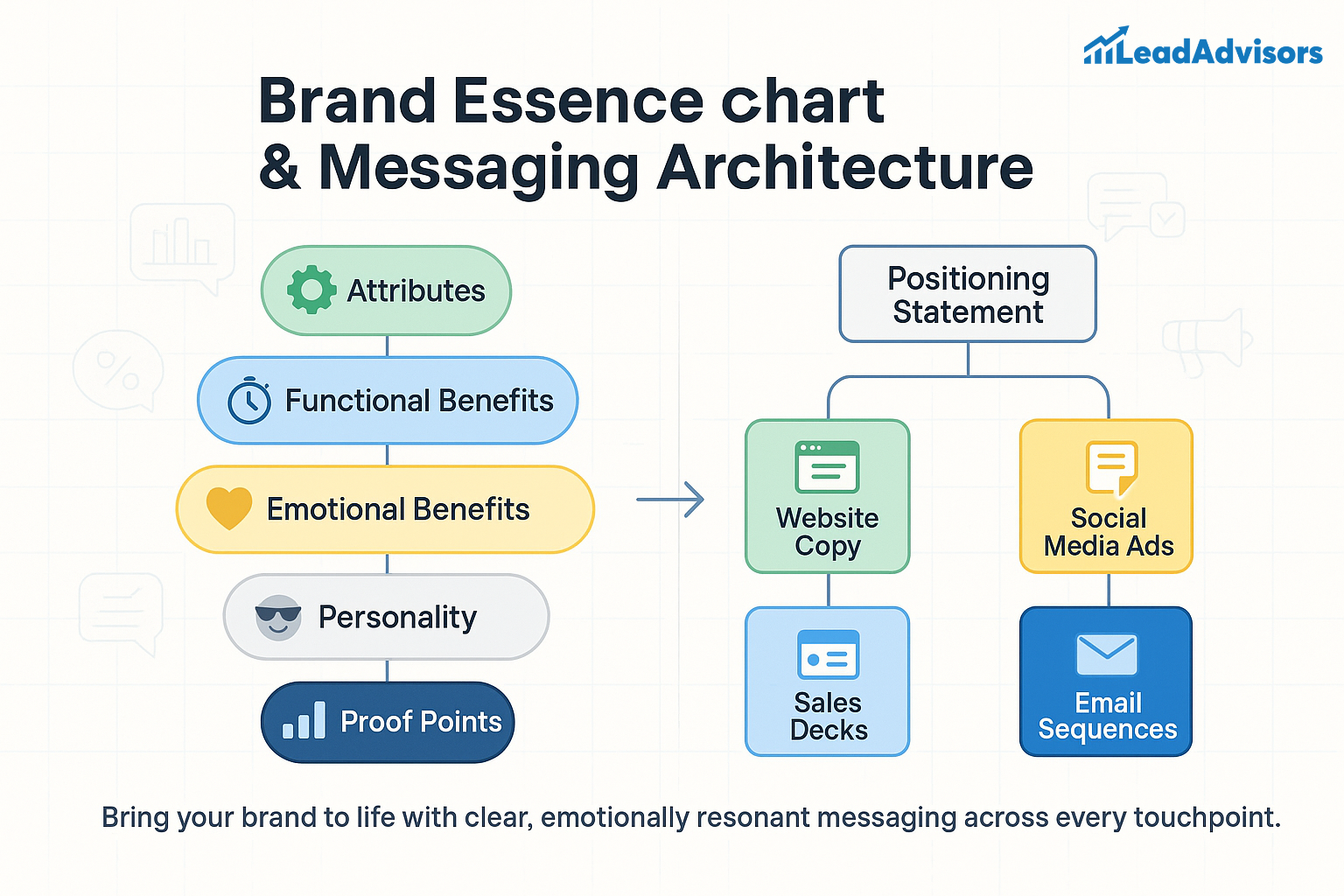
You’ve nailed your brand positioning—now what? Now, it’s time to bring that strategy to life in a way that keeps your brand messaging consistent and emotionally engaging everywhere it appears. That’s where your Brand Essence Chart and Messaging Architecture come in.
Now, back to the brand essence chart. You can think of it as your brand’s emotional DNA. It’s a formal snapshot of everything your brand represents—from the logical to the emotional. It takes you from what you sell to how it makes people feel. And more importantly, it is a great tool to keep everyone on your team on the same page, whether you’re writing a headline or planning a launch of a new product or service.
Here’s an example of what a basic brand essence chart will include:
- Attributes – Who are you (Reliable, Brave, Efficient)
- Functional Benefits – What you do for your target audience (e.g., save time, reduce hassle)
- Emotional Benefits – The emotions that your prospective customers feel (i.e., confident, safe, exhilarated)
- Personality – The way your brand appears (friendly, professional, edgy)
- Proof Points – Where is the data that supports it (e.g., customer references, data, case studies)?
After you’ve identified your brand essence, we build the messaging architecture. Essentially, this is your communication strategy. It begins with your positioning statement, which goes at the very top, then spreads out into custom messaging for your website, sales decks, inbound marketing campaigns, social media, email flows, and the like.
Here’s the beauty of this system: with rare exception, you’re not rehashing the wheel at every point. Your messaging structure establishes cohesion and makes your marketing efforts feel in harmony. When you speak with those interested customers, diehard fans, or industry heavyweights, your brand effectively does a pretty good job of sounding just like you.
When you mix emotional clarity with structured storytelling, your brand looks and feels cohesive. And that’s how you convert attention to trust and trust to loyal conversions.
Common Brand Positioning Pitfalls to Avoid
One thing is developing a strong brand positioning; another is sustaining it without succumbing to common traps. Even the most well-intentioned brands can lose their edge if they don’t pay attention.
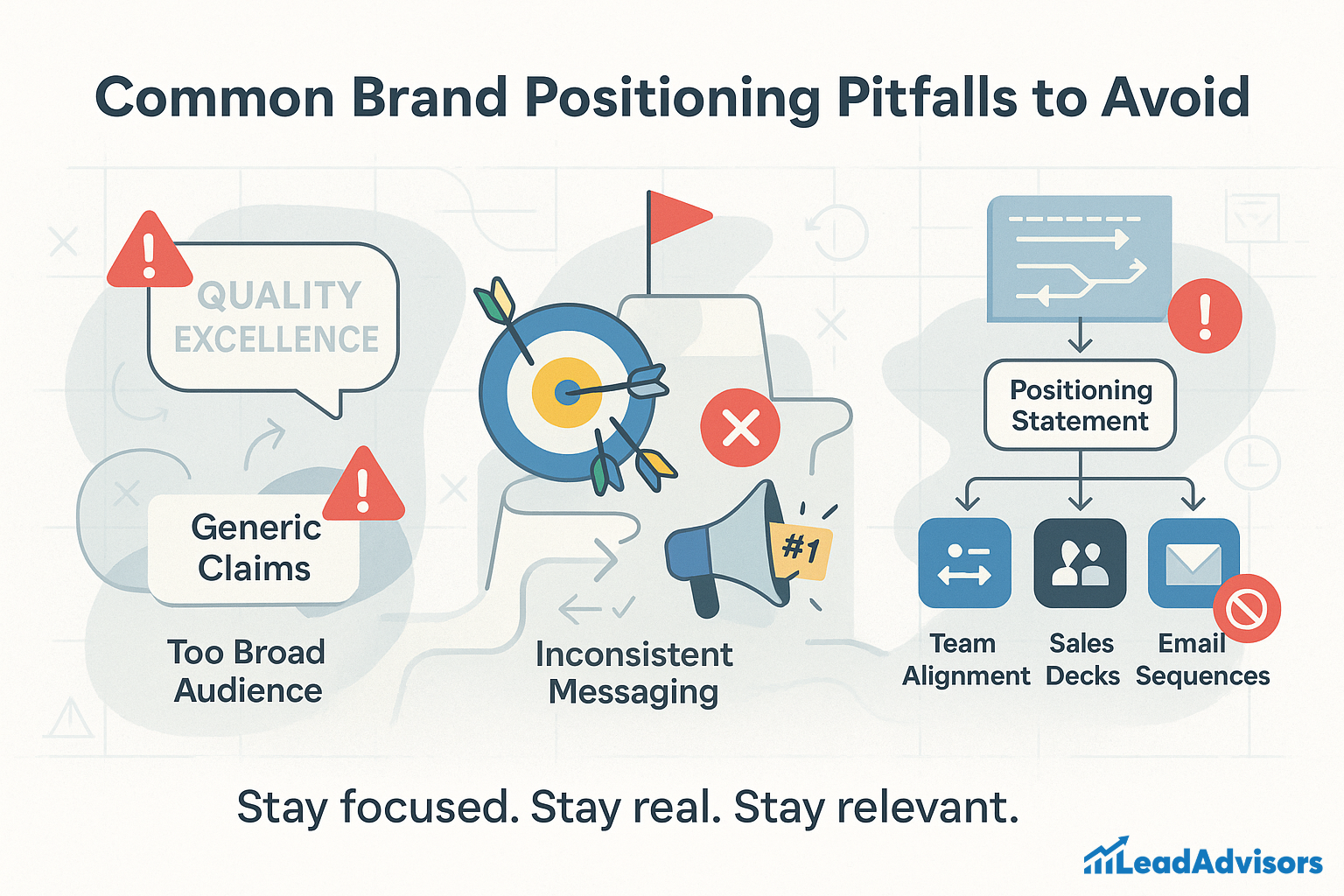
As you develop or refine your brand positioning strategy, here are a few traps to avoid:
1. Relying on Generic Claims
Words like “high quality” or “excellent service” are all good, but they fall flat if you don’t provide further detail on why you deserve those accolades. If there should be other brands within your service category that can claim the same thing, it’s not a unique value proposition. Instead, double down on what allows your brand’s unique qualities to stand out — and support them with evidence. That’s the way you build trust and a genuine competitive advantage.
2. Going Too Broad With Your Audience
Trying to speak to everyone? That, in other words, is another way of saying you are resonating with no one. If you don’t define your target market, you will erode your positioning strategy and make it generic. The best brands have a clear picture of their target audience and speak directly to what they believe and how they feel.
3. Being Inconsistent Across Touchpoints
Your website says one thing, your sales team says another, and your social media is doing its own thing—it’s confusing. Misalignment can quickly destroy trust. Your brand positioning statement should serve as the guiding star for all of your marketing strategies and brand messaging<span style=”font-weight: 400;”>.
4. Making Overpromises or Claims You Can’t Prove
It can be tempting to use bold language to differentiate yourself, but if it’s not based in truth, then you may do more harm than good. Justifiable with evidence, such as customer feedback, case studies, or data. Just remember: a good positioning statement should be aspirational, but achievable and provable.
5. Failing to Evolve With the Market
What was successful for your brand three years ago may not be successful now. If you’re not growing, consumer perception of you could become dated or out of touch. It’s these ongoing market share analysis, brand awareness surveys, and competitive analysis that keep your finger on the pulse, and your positioning strategy new.
These faux pas are often silent killers of even the best-conceived brand strategies. But by maintaining focus, consistency, and the willingness to adjust, you will keep your brand positioning strong, fresh, and totally unforgettable.
Evolving Your Positioning Over Time
Here’s the truth that people miss: brand positioning isn’t something you create once and forget. It’s not a final destination — it’s a strategic direction. Branding pro John Gerzema said that your positioning strategy should tell you where you are going, not anchor you where you’ve been.

Markets change, consumer perception changes, and new players enter the game. Which is why it’s important to take a step back once in a while and ask yourself: Is our current brand positioning still connecting with our target audience?
This is where brand awareness surveys, market share analysis, and customer feedback can be your best friends. Whether you’re analyzing your marketing strategies, assessing the consistency of your messaging, or diving deep into engagement data, these insights can help ensure your brand positioning strategy stays relevant and nimble.
Eventually, small adjustments may not be enough. That’s when it’s time to ask:
- Do we need to fix our messaging?
- Do we have to rebrand with a benefit statement to get more out of our brand?
- Or do we need to start from scratch?
So don’t be afraid to evolve. The most successful brand positioning strategies are flexible. The strongest brands aren’t static—they’re self-aware, responsive, and always aligned with where their target customers are headed next.
A refresh might involve reining in your tone or refreshing visuals. Repositioning could mean zooming in on a new benefit or focusing on where your brand’s unique strengths lie. And a rebrand? That’s a bigger move — new name, look, and brand identity. But sometimes, that’s what is required to defend your market leader position or reclaim mind and market shares in a crowded marketplace.
So don’t be afraid to evolve. The most successful brand positioning is adaptable. The most powerful brands aren’t fixed—they’re self-aware, adaptive, and ever conscious of relocating their target customers to work with them next.
Measuring the Success of Your Brand Positioning & Brand Strategy
So, how do you know whether your brand positioning is working? The good news is, you don’t have to trust your gut. There are some downright trackable indicators for figuring out whether your positioning strategy is reaching the right people and making the right kind of impact.
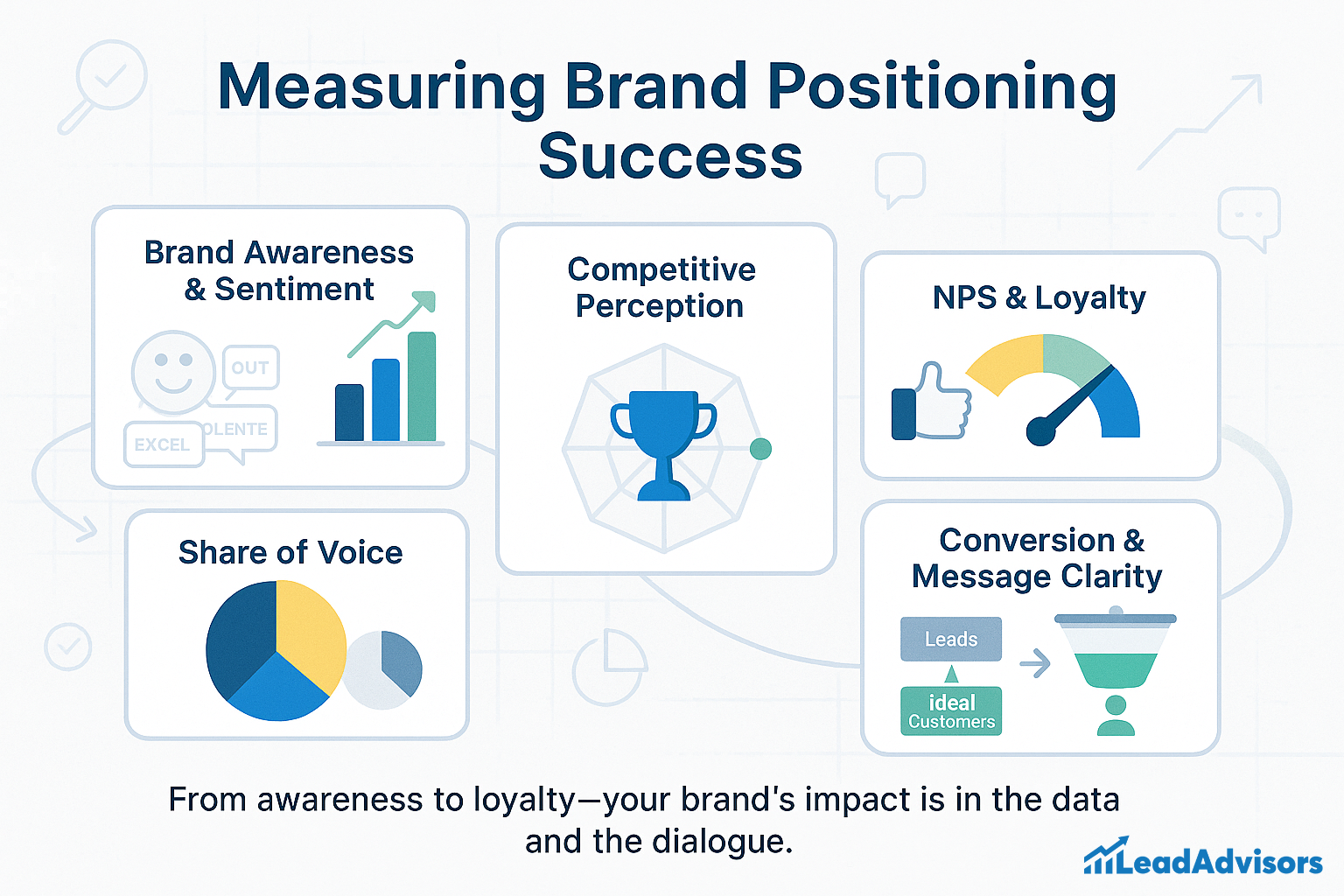
Brand Awareness and Sentiment
Are folks acknowledging your brand and feeling positive about it? Brand awareness surveys, social listening, and organic brand mentions are great ways to gain solid insights into how your target audience perceives you. If this consumer perception correlates with the brand identity you want to project, you’re doing it right.
Competitive Perception
Do people associate your existence with the value you profess? If you’re competitors are still driving the conversation in your industry, now might be the time to revisit your brand positioning statement or tighten up your differentiation strategy. What are your brand’s unique strengths and differentiators that help you stand out from the crowd?
Customer Loyalty & Advocacy Metrics
Watch NPS, repeat business, and referrals closely. These are strong aspects of brand loyalty and confidence. When your value proposition hits home, your customers not only buy, they advocate.
Look for signals like:
- Are people who use your brand’s differentiating qualities?
- Is your brand increasing its share of voice in comparison to competitors?
- Are you creating a customer base that sticks?
Conversion Rates & Fit
This is where your positioning strategy converges with the results. Can leads convert because they understand what you stand for? Are you courting your target customers (the ones who share your message, values, and solutions)?
If your product or service has struck a chord, then conversions come easily. With everything from your brand messaging to your offer feeling aligned, it’s easier for customers to say “yes.”
When your brand positioning is really on point, it is reflected back to you in all kinds of data and stories that people tell. Your target customers not only notice you—they remember you, trust you, and hire you.
Conclusion: Positioning Is Not Optional — It’s Foundational
If you don’t take charge of your brand positioning, the market will take control of it for you, and chances are, it won’t get the story straight. A positioning strategy is not a nice-to-have. It is the invisible thread that ties your brand promise to your marketing strategies, brand messaging, and customer experience.
Good brand positioning is the connection between what you say and how your target audience feels. It reflects your intention against the backdrop of consumer perception, and if you do it well, you create a memorable, reliable, and repeatable experience—one that sticks, not just in the minds of buyers but also in their records of who they buy from.
And let’s all remember that this isn’t about jumping on trends or clever taglines. It’s about drilling down and clearly defining your brand’s unique place globally. It’s about creating a formal positioning statement that keeps every campaign rooted in that idea and dictates how you position your brand across touchpoints, from web to email, to sales, to support.
You’re building brand loyalty, competitive advantage, and a brand that grows with intention, not guessing at the magic.”
So, if you have been treating your brand positioning as just another bullet point on your website, this is your wake-up call. In a crowded marketplace, the names that stand out are those who know who they are and never let the market forget it.











